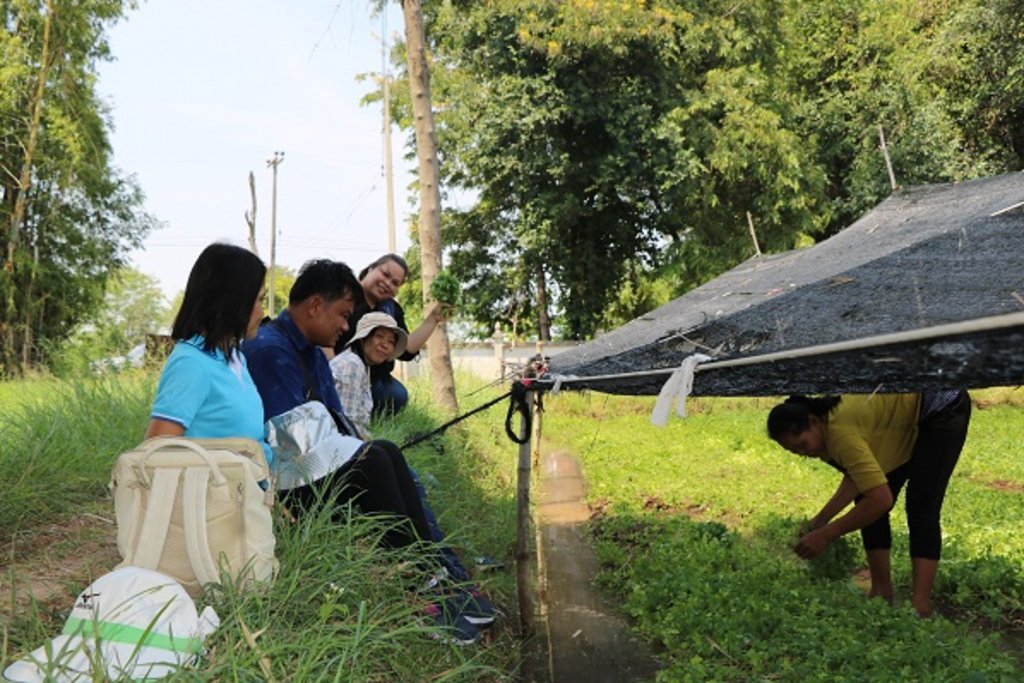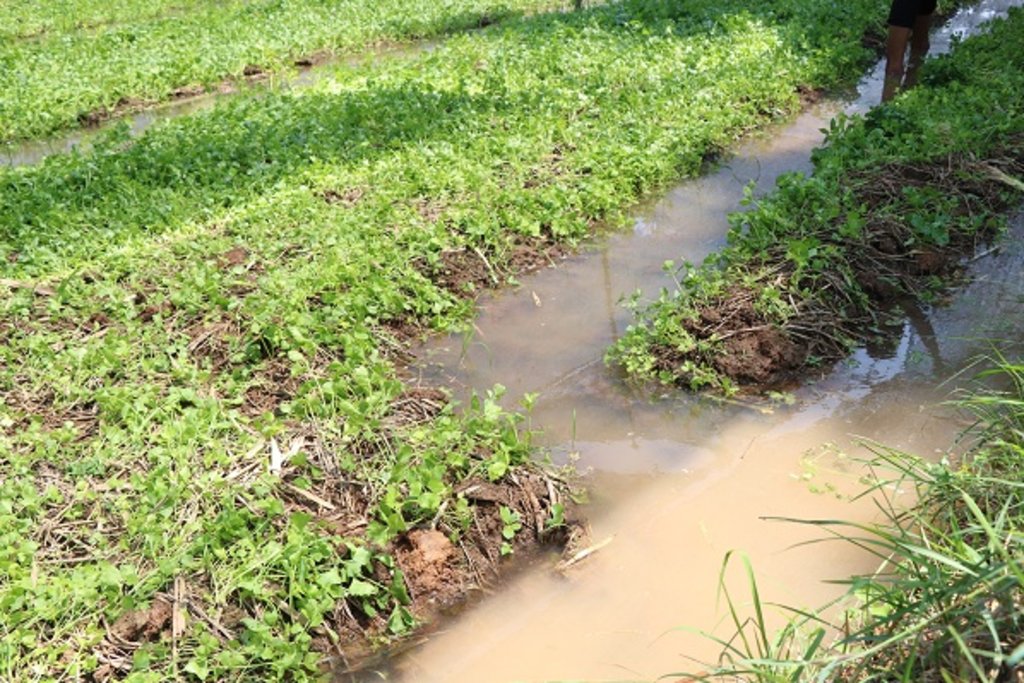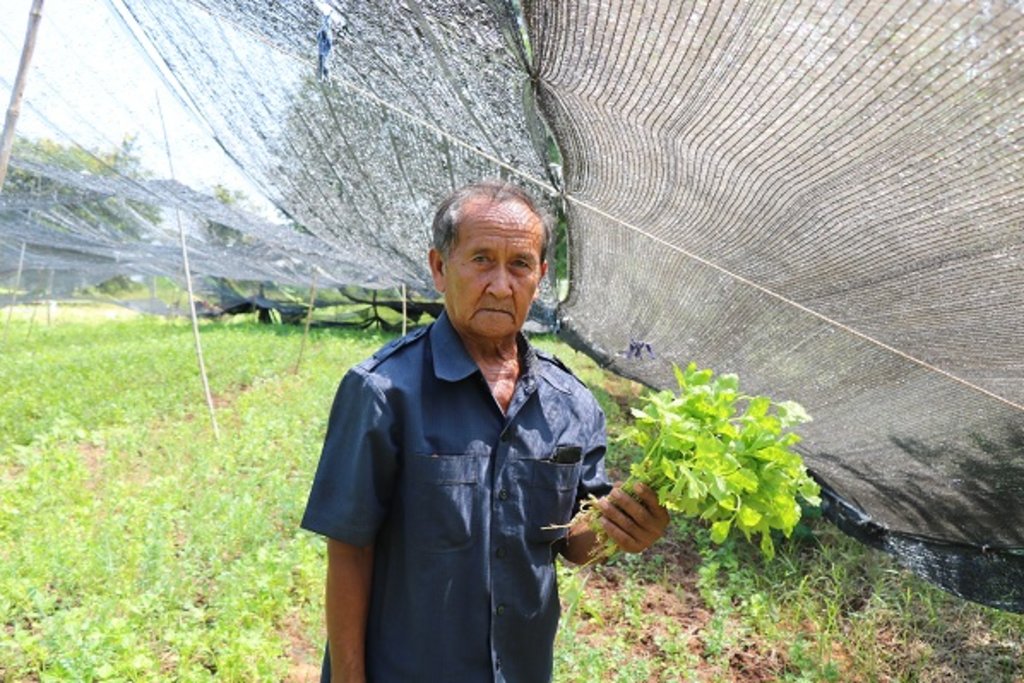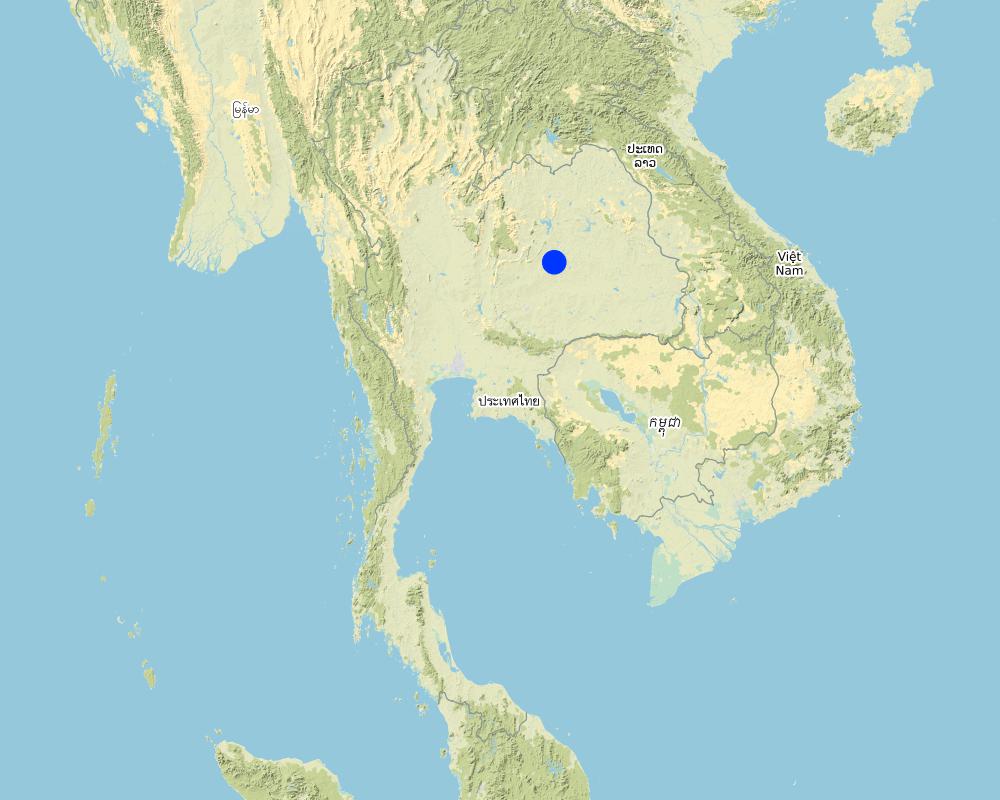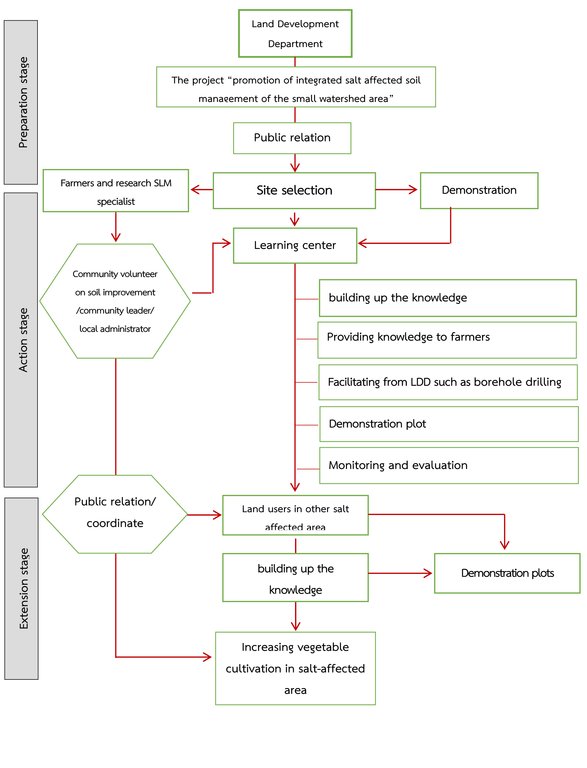Pumping groundwater for vegetable irrigation to prevent salination [Thaïlande]
- Création :
- Mise à jour :
- Compilateur : supranee sritumboon
- Rédacteur : –
- Examinateurs : Rima Mekdaschi Studer, Pitayakon Limtong, William Critchley
approaches_4298 - Thaïlande
Voir les sections
Développer tout Réduire tout1. Informations générales
1.2 Coordonnées des personnes-ressources et des institutions impliquées dans l'évaluation et la documentation de l'Approche
Personne(s) ressource(s) clé(s)
Somked Boonmee
Thaïlande
Spécialiste GDT:
Sihaban Pranee
pranee782@gmail.com
Land Development Department Regional Office 5
Thaïlande
Spécialiste GDT:
Sritumboon Supranee
ssritumboon@yahoo.com
Land Development Department Regional Office 5
Thaïlande
Spécialiste GDT:
Jakkarach Usa
usa_kl@hotmail.com
Land Development Department Regional Office 5
Thaïlande
Spécialiste GDT:
Rophandung Weera
weerop@hotmail.com
Land Development Department Regional Office 5
Thaïlande
Spécialiste GDT:
Phothinam Pornpana
laosuwan18@hotmail.com
Land Development Department Regional Office 5
Thaïlande
Spécialiste GDT:
National Consultant:
Arunin Somsri
ssarunin@gmail.com
Land Development Department
Thaïlande
Nom du projet qui a facilité la documentation/ l'évaluation de l'Approche (si pertinent)
Decision Support for Mainstreaming and Scaling out Sustainable Land Management (GEF-FAO / DS-SLM)Nom du projet qui a facilité la documentation/ l'évaluation de l'Approche (si pertinent)
Book project: where people and their land are safer - A Compendium of Good Practices in Disaster Risk Reduction (DRR) (where people and their land are safer)Nom du projet qui a facilité la documentation/ l'évaluation de l'Approche (si pertinent)
Book project: where the land is greener - Case Studies and Analysis of Soil and Water Conservation Initiatives Worldwide (where the land is greener)Nom du ou des institutions qui ont facilité la documentation/ l'évaluation de l'Approche (si pertinent)
Land Development Department LDD (Land Development Department LDD) - Thaïlande1.3 Conditions relatives à l'utilisation par WOCAT des données documentées
Le compilateur et la(les) personne(s) ressource(s) acceptent les conditions relatives à l'utilisation par WOCAT des données documentées:
Oui
2. Description de l'Approche de GDT
2.1 Courte description de l'Approche
The approach is to develop a simple groundwater pumping model for irrigation, on the basis of cooperation and knowledge sharing between government agencies and farmers, that addresses the risk and prevention of off-site salination.
2.2 Description détaillée de l'Approche
Description détaillée de l'Approche:
The objective of groundwater pumping for irrigation is to lower the groundwater level in the recharge zone which in turn decreases soil salinity lower down in the discharge area. The extension and promotion of the approach has been done through the learning and training center. The goal is better understanding and public awareness of preventive measure against salinity, through the use of salt-tolerant crops, combined with mechanical measures of accessing groundwater for irrigation. This has been achieved in close cooperation among researchers, SLM specialists, local administration, and community volunteers on soil improvement. A group of farmers started this activity in 1996 under the Land Development Department (LDD)’s Project on Promotion of Integrated Salt-Affected Soil Management of Small Watershed Areas. The approach aims at scaling-out the model to farmers in the recharge areas with the objectives of sharing benefits that are to (a) persuade other land users to change their land use from rice which is a high water-use crop to low water-use crops such as vegetables, (b) prevent further off-site salination, (c) increase land users’ income, and (d) provide knowledge about integrated salinity management. Researchers and SLM specialists work closely with farmers in monitoring and evaluating the recharge area to prevent extensive salination in the discharge zone - as well as the use of groundwater for irrigation. This plan has been formulated to stimulate further promotion and extension to other areas with a similar environment, through training and public relations. The four stages were: first, the expert and agriculturalist of the LDD’s Regional Office 5 (LDDRO5) cooperated with the volunteer soil doctor and farmers in the community to design and plan the project; second, the officers of LDDRO5 set up a forum for exchange of knowledge and experiences between farmers who have been successful in producing vegetables through using shallow groundwater for agriculture, and are not affected by a salinity. Thirdly, the officers of LDDRO5 collaborated with the government office in the district to train farmers who had an interest in vegetable production. Fourthly, LDDRO5 created incentives for farmers to change areas that are not suitable for planting paddy rice to grow vegetables by supporting shallow groundwater well through pumping with solar energy. The stakeholders include the LDD, SLM specialists and researchers, local administrators, and community volunteers on soil improvement and land users. Land users like the project activities because they receive higher incomes – partially because they do not lose land to digging ponds, but instead irrigate from these deep wells from which they can irrigate all year round. The LDD has supported borehole drilling wells – but farmers are not so happy when they have to wait for over a year to get LDD’s borehole drilling due to budget limitations.
2.3 Photos de l'approche
Remarques générales concernant les photos:
Vegetable cultivation was developed based on farmer experience.
2.4 Vidéos de l'Approche
Date:
02/10/2018
Lieu:
Ban Kaonoi
Nom du vidéaste:
Supranee Sritumboon
2.5 Pays/ région/ lieux où l'Approche a été appliquée
Pays:
Thaïlande
Région/ Etat/ Province:
Khon Kaen
Autres spécifications du lieu :
Ban Kaonoi
Map
×2.6 Dates de début et de fin de l'Approche
Indiquez l'année de démarrage:
2007
Si l'année précise est inconnue, indiquez approximativement quand l'Approche a démarré:
il y a entre 10-50 ans
2.7 Type d'Approche
- fondé sur un projet/ programme
2.8 Principaux objectifs de l'Approche
The objectives of the approach are to persuade land users in the recharge zone to change their land use to low-water use such as vegetable cultivation, to prevent further off-site salination, to increase land users’ income and provide knowledge of integrated salinity management.
2.9 Conditions favorisant ou entravant la mise en œuvre de la(des) Technologie(s) appliquée(s) sous l'Approche
normes et valeurs sociales/ culturelles/ religieuses
- favorise
Farmers' community
disponibilité/ accès aux ressources et services financiers
- favorise
Farmers get higher income from vegetables.
collaboration/ coordination des acteurs
- favorise
Researchers, SLM specialists and farmers are working together to implement the project.
connaissances sur la GDT, accès aux supports techniques
- favorise
Provide knowledge of integrated salinity management to farmers.
marchés (pour acheter les intrants, vendre les produits) et prix
- favorise
Farmers can produce plants according to market demand.
3. Participation et rôles des parties prenantes impliquées dans l'Approche
3.1 Parties prenantes impliquées dans l'Approche et rôles
- exploitants locaux des terres / communautés locales
Farmers
Vegetable cultivation
- Spécialistes de la GDT/ conseillers agricoles
Government officers
Support knowledge and technology
- gouvernement local
Subdistrict Administration Organization
Support information
- community volunteer on soil
Community volunteers on soil and successful farmers
Share knowledge and experience
Si plusieurs parties prenantes sont impliquées, indiquez l'organisme chef de file ou l'institution responsable:
Land Development Department Regional Office 5
3.2 Participation des exploitants locaux des terres/ communautés locales aux différentes phases de l'Approche
| Participation des exploitants locaux des terres/ communautés locales | Spécifiez qui était impliqué et décrivez les activités | |
|---|---|---|
| initiation/ motivation | interactive | Farmers had developed knowledge and technology by themselves |
| planification | auto-mobilisation | Cultivation planning by farmers |
| mise en œuvre | interactive | Farmers had implemented by themselves and were supported by the government |
| suivi/ évaluation | interactive | The government officers are monitoring and evaluating after the project was implemented |
3.3 Diagramme/ organigramme (si disponible)
3.4 Prises de décision pour la sélection de la Technologie/ des Technologies
Indiquez qui a décidé de la sélection de la Technologie/ des Technologies à mettre en œuvre:
- les exploitants des terres seuls (auto-initiative)
Spécifiez sur quelle base ont été prises les décisions:
- expériences et opinions personnelles (non documentées)
4. Soutien technique, renforcement des capacités et gestion des connaissances
4.1 Renforcement des capacités/ formation
Une formation a-t-elle été dispensée aux exploitants des terres/ autres parties prenantes?
Oui
Spécifiez qui a été formé:
- exploitants des terres
Formats de la formation:
- entre agriculteurs (d'exploitants à exploitants)
Thèmes abordés:
Promotion of integrated salt-affected soil management of the small watershed area.
Commentaires:
The topic covered vegetable production and salt-affected soil management.
4.2 Service de conseils
Les exploitants des terres ont-ils accès à un service de conseils?
Non
4.3 Renforcement des institutions (développement organisationnel)
Des institutions ont elles été mises en place ou renforcées par le biais de l'Approche?
- oui, beaucoup
Spécifiez à quel(s) niveau(x), ces institutions ont été renforcées ou mises en place:
- local
Décrivez l'institution, ses rôles et responsabilités, ses membres, etc.
The learning and transferring center of land development technology was set up in the community to be used as a training facility, meeting, discussion, and sharing knowledge among farmers and officials.
Précisez le type de soutien:
- renforcement des capacités/ formation
4.4 Suivi et évaluation
Le suivi et l'évaluation font ils partie de l'Approche? :
Oui
Commentaires:
Government officers, community volunteers on soil improvement and farmers.
Si oui, ce document est-il destiné à être utilisé pour le suivi et l'évaluation?
Oui
4.5 Recherche
La recherche a-t-elle fait partie intégrante de l’Approche?
Non
5. Financement et soutien matériel externe
5.1 Budget annuel de la composante GDT de l'Approche
Si le budget annuel précis n'est pas connu, indiquez une fourchette:
- 10 000-100 000
5.2 Soutiens financiers/ matériels fournis aux exploitants des terres
Les exploitants des terres ont-ils reçu un soutien financier/ matériel pour la mise en œuvre de la Technologie/ des Technologies?
Non
5.3 Subventions pour des intrants spécifiques (incluant la main d'œuvre)
- équipement
| Spécifiez les intrants subventionnés | Dans quelle mesure | Spécifiez les subventions |
|---|---|---|
| outils | en partie financé | Land Development Department Regional Office 5 supported water pump using solar energy. |
Si la main d'œuvre fournie par les exploitants des terres était un intrant substantiel, elle était:
- payée en espèces
5.4 Crédits
Des crédits ont-ils été alloués à travers l'Approche pour les activités de GDT?
Non
5.5 Autres incitations ou instruments
D'autres incitations ou instruments ont-ils été utilisés pour promouvoir la mise en œuvre des Technologies de GDT?
Non
6. Analyses d'impact et conclusions
6.1 Impacts de l'Approche
Est-ce que l'Approche a autonomisé les exploitants locaux des terres, amélioré la participation des parties prenantes?
- Non
- Oui, un peu
- Oui, modérément
- Oui, beaucoup
Cooperation between the government and farmers.
Est-ce que l'Approche a aidé les exploitants des terres à mettre en œuvre et entretenir les Technologies de GDT?
- Non
- Oui, un peu
- Oui, modérément
- Oui, beaucoup
Farmers have a better understanding of the technology and willing to maintain it due to the good result.
Est-ce que l'Approche a amélioré les connaissances et les capacités des exploitants des terres pour mettre en œuvre la GDT?
- Non
- Oui, un peu
- Oui, modérément
- Oui, beaucoup
Farmers have adopted the technology to suit their own area.
Est-ce que l'Approche a amélioré les connaissances et les capacités des autres parties prenantes?
- Non
- Oui, un peu
- Oui, modérément
- Oui, beaucoup
The approach presented the efficient technology to develop salination for the stakeholders.
Est-ce que l'Approche a conduit à améliorer la sécurité alimentaire et/ou la nutrition?
- Non
- Oui, un peu
- Oui, modérément
- Oui, beaucoup
Different types of vegetables leads to better food security.
Est-ce que l'Approche a amélioré l'accès aux marchés?
- Non
- Oui, un peu
- Oui, modérément
- Oui, beaucoup
Higher productivity draws merchants into the project area.
Est-ce que l'Approche a conduit à des emplois, des opportunités de revenus?
- Non
- Oui, un peu
- Oui, modérément
- Oui, beaucoup
The higher productivity and the wider area used for such technology cause more labour demand resulting in higher employment of people in the area.
6.2 Principale motivation des exploitants des terres pour mettre en œuvre la GDT
- augmenter la production
Increase variety of product in the area
- réduire la dégradation des terres
Decrease salt distribution in soil
6.3 Durabilité des activités de l'Approche
Les exploitants des terres peuvent-ils poursuivre ce qui a été mis en œuvre par le biais de l'Approche (sans soutien extérieur)?
- oui
Si oui, décrivez de quelle manière:
Farmers have a better understanding of off-site salination and they can develop the technology by themselves.
6.4 Points forts/ avantages de l'Approche
| Points forts/ avantages/ possibilités du point de vue de l'exploitant des terres |
|---|
| Farmers get higher income from vegetable cultivation. |
| Land users have water to use for agriculture all year round. |
| Points forts/ avantages/ possibilités du point de vue du compilateur ou d'une autre personne ressource clé |
|---|
| Increase the varieties of agricultural products. |
| Lower the groundwater level and control the salinity that might spread toward the discharge area. |
6.5 Faiblesses/ inconvénients de l'Approche et moyens de les surmonter
| Faiblesses/ inconvénients/ risques du point de vue de l’exploitant des terres | Comment peuvent-ils être surmontés? |
|---|---|
| Farmers wait for more than one year to get help from LDD for borehole drilling due to limited budget. | Increase more government budget or farmers have to invest by themselves. |
| Faiblesses/ inconvénients/ risques du point de vue du compilateur ou d'une autre personne ressource clé | Comment peuvent-ils être surmontés? |
|---|---|
| High initial implementation cost if the farmers do not receive government support. | Farmers have to search for funds to invest by themselves. |
7. Références et liens
7.1 Méthodes/ sources d'information
- visites de terrain, enquêtes sur le terrain
Visit two land user's fields
- interviews/entretiens avec les exploitants des terres
Interview with one farmer
- interviews/ entretiens avec les spécialistes/ experts de GDT
A Land Development Department officer
7.2 Références des publications disponibles
Titre, auteur, année, ISBN:
Land Development Department
Disponible à partir d'où? Coût?
http://www.ldd.go.th/
7.3 Liens vers les informations pertinentes disponibles en ligne
Titre/ description:
where the land is greener - Case Studies and Analysis of Soil and Water Conservation Initiatives Worldwide
URL:
https://www.wocat.net/library/media/27/
Titre/ description:
where people and their land are safer - A Compendium of Good Practices in Disaster Risk Reduction (DRR) (where people and their land are safer) URL:
URL:
https://www.wocat.net/en/projects-and-countries/projects/drr
Liens et modules
Développer tout Réduire toutLiens
Aucun lien
Modules
Aucun module trouvé



